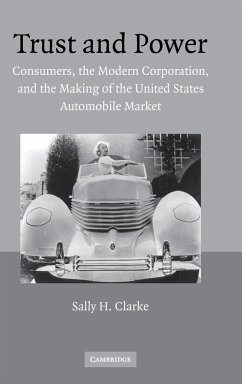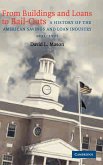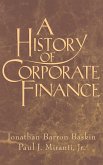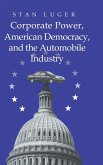Trust and Power argues that automobile corporations have historically faced conflicts with the very customers whose loyalty they sought.
Trust and Power argues that corporations have faced conflicts with the very consumers whose loyalty they sought. The book provides novel insights into the dialogue between modern corporations and consumers by examining the car industry during the twentieth century. In the new market at the turn of the century, car manufacturers produced defective cars, and consumers faced risks of physical injuries as well as financial losses. By the 1920s, cars were sold in a mass market where state agencies intervened to monitor, however imperfectly, product quality and fair pricing mechanisms. After 1945, the market matured as most U.S. families came to rely on car transport. Again, the state intervened to regulate relations between buyers and sellers in terms of who had access to credit, and thus the ability to purchase expensive durables like cars.
Review quote:
"When the 20th century began, hardly anyone owned a car, and when it ended about nine of every ten American families had a car or two ... or three. In this richly textured economic, business, and social history, Sally Clarke tells us how that happened. Car makers marketed a captivating range of products, dealers intermediated between them and consumers, and the government helped out by expanding the availability of credit. Ride along with Clarke as she drives home her learned analysis of how America became a "car culture.""
Richard Sylla, Henry Kaufman Professor of the History of Financial Institutions and Markets, and Professor of Economics Stern School of Business New York University
Table of contents:
Part I. A New Market, 1896(?)1;1916: 1. Risks of innovation, risks of injury; 2. New firms and the problem of social costs; Part II. A Mass Market, 1916(?)1;1941: 3. Corporate strategies and consumers' loyalty; 4. Engineering a mass product; 5. A machine age aesthetic; 6. The franchised car dealer and consumers' marketing dilemma; Part III. A Mature Market, 1945(?)1;1965: 7. Automobiles and institutional change; Conclusion.
Hinweis: Dieser Artikel kann nur an eine deutsche Lieferadresse ausgeliefert werden.
Trust and Power argues that corporations have faced conflicts with the very consumers whose loyalty they sought. The book provides novel insights into the dialogue between modern corporations and consumers by examining the car industry during the twentieth century. In the new market at the turn of the century, car manufacturers produced defective cars, and consumers faced risks of physical injuries as well as financial losses. By the 1920s, cars were sold in a mass market where state agencies intervened to monitor, however imperfectly, product quality and fair pricing mechanisms. After 1945, the market matured as most U.S. families came to rely on car transport. Again, the state intervened to regulate relations between buyers and sellers in terms of who had access to credit, and thus the ability to purchase expensive durables like cars.
Review quote:
"When the 20th century began, hardly anyone owned a car, and when it ended about nine of every ten American families had a car or two ... or three. In this richly textured economic, business, and social history, Sally Clarke tells us how that happened. Car makers marketed a captivating range of products, dealers intermediated between them and consumers, and the government helped out by expanding the availability of credit. Ride along with Clarke as she drives home her learned analysis of how America became a "car culture.""
Richard Sylla, Henry Kaufman Professor of the History of Financial Institutions and Markets, and Professor of Economics Stern School of Business New York University
Table of contents:
Part I. A New Market, 1896(?)1;1916: 1. Risks of innovation, risks of injury; 2. New firms and the problem of social costs; Part II. A Mass Market, 1916(?)1;1941: 3. Corporate strategies and consumers' loyalty; 4. Engineering a mass product; 5. A machine age aesthetic; 6. The franchised car dealer and consumers' marketing dilemma; Part III. A Mature Market, 1945(?)1;1965: 7. Automobiles and institutional change; Conclusion.
Hinweis: Dieser Artikel kann nur an eine deutsche Lieferadresse ausgeliefert werden.
"When the 20th century began, hardly anyone owned a car, and when it ended about nine of every ten American families had a car or two ... or three. In this richly textured economic, business, and social history, Sally Clarke tells us how that happened. Car makers marketed a captivating range of products, dealers intermediated between them and consumers, and the government helped out by expanding the availability of credit. Ride along with Clarke as she drives home her learned analysis of how America became a "car culture."" Richard Sylla, Henry Kaufman Professor of the History of Financial Institutions and Markets, and Professor of Economics Stern School of Business New York University









